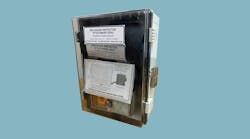Passive Device Keeps Electrical and Electronic Enclosures Sealed Tight
The Enclosure Protector Attachment (EPA) from Inventive Resources is a passive device designed to safeguard electrical and electronic enclosures from environmental contamination, promising to extend equipment life and improve reliability under harsh operating conditions.
Intended for NEMA Type 4 enclosures and similar cabinets, the EPA device balances internal and external air pressure. It continuously treats the sealed enclosure air without requiring external power to regulate temperature and pressure.
Electrical enclosures are used in industries ranging from manufacturing, utilities, transportation, marine, and healthcare that often grapple with harsh environmental conditions. But these enclosures face constant temperature, pressure, and humidity challenges that can reduce reliability and increase the wear and tear on internal components.
Temperature swings, wind, or barometric pressure changes cause internal air in a sealed enclosure to expand or contract, resulting in outside air leaking into the enclosure when internal pressure drops. This air carries moisture and contaminants such as dust and other corrosive particles, and as it cools, it can create condensation, dripping water on electronic and electrical components.
According to Inventive, that could lead to corrosion, shorts, malfunctions, failures, and other issues, resulting in more frequent service and repairs, increasing operation and maintenance costs.
Traditional methods provide necessary air conditioning for thermal management while containing filters and dessicants to remove contaminants and dry out the inside of the enclosure. However, these approaches consume energy and require regular maintenance. On top of that, they still allow air leakage. In effect, current solutions treat symptoms instead of the root cause, leaving enclosures vulnerable to moisture and pollutants, said Inventive.
How the EPA Overcomes Traditional Treatment Issues
The EPA tackles these challenges by eliminating enclosure pressure differentials and preventing airborne contaminant entry. A lightweight flexible bladder inside the unit connects to the enclosure air volume, expanding or contracting when air warms or cools to keep the pressure inside the enclosure equal to the ambient pressure, within specified temperature limits.
The EPA virtually converts the “fixed volume enclosure” into a “variable volume enclosure." By stabilizing the pressure, Inventive said the EPA prevents outside air and any contaminants that come with it from leaking into the enclosure.
Passive air circulation inside the enclosure helps keep the air clean, dry, and nitrogen-rich, which protects all internal components from moisture, dust, and corrosion, eliminating the source of contamination. The integrated relief valves ensure safety by limiting excess pressure differentials.
How it works is that a heat pipe forms a cool spot, lowering the air temperature in a conduit, increasing air density, and causing it to circulate through the treatment chamber. The internal treatment chamber with a replaceable desiccant and oxygen absorber continuously dries and captures oxygen molecules in the enclosure air, keeping the interior filled with a high concentration of inert nitrogen.
The EPA requires no external power or mechanical parts, which increases reliability while reducing maintenance and component replacement costs. It can also be easily installed inside new enclosures or retrofitted to existing ones. According to the company, the EPA works with enclosures of any size or shape. It's compact and mounts to the enclosure, using only small tubing to connect the unit to the enclosure.
The EPA is a patent-pending design that can be used in any facility using NEMA 4 (or similar) enclosures. Inventive said the EPA delivers significant cost savings and optimizes performance by eliminating moisture-related failures and reducing maintenance. As a low-cost, simple retrofit in an era of increasing automation and reliability demands, the device helps extend equipment life and reduce operational risk.

